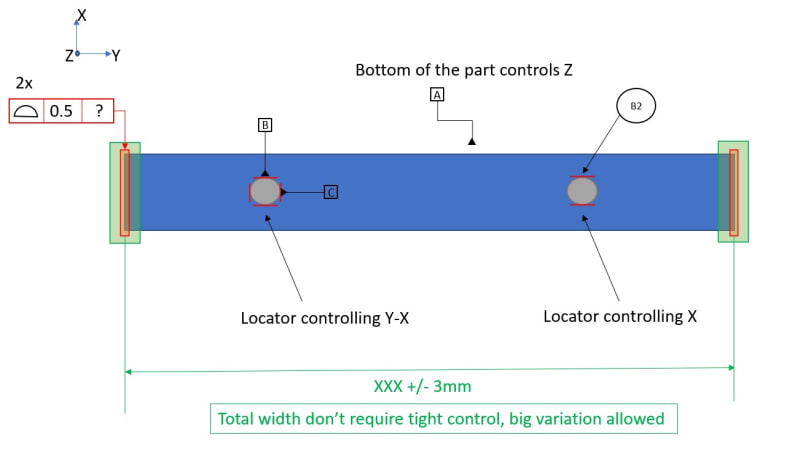roller_delawer
Automotive
- Jan 15, 2017
- 13
Hi all,
I have this rectangular part which I want to tightly control both edges profiles, but I want to give my supplier some freedome to produce longer or shorter parts (as long as the edge itself looks good).
It's almost like we want to create two different areas for each edge. One large area (green) and another small area (red). The profile condition will be good as long as the edge is within the red, and the red is within the green. Also, the red and green areas need to be alligned with x & y, as we can't accept a tapered condition.
To complicate the things a bit more, the locator that controls Y position is not centered, so the distance to one edge is different to the other. And none of us is sure how to make the GD&T for this particular case.

We're only sure of two things:
A) Profile of a surface to A|B|C. That will constraint the total width too, and will require to open the tolerance on the edge that is further from the locator. Not what we want.
B) Width dimension with large tolerance + Profile of a surface without datum reference. That will avoid the edge being wobly, but will open the door for a tapered condition.
Any help will be welcome!
Thanks
I have this rectangular part which I want to tightly control both edges profiles, but I want to give my supplier some freedome to produce longer or shorter parts (as long as the edge itself looks good).
It's almost like we want to create two different areas for each edge. One large area (green) and another small area (red). The profile condition will be good as long as the edge is within the red, and the red is within the green. Also, the red and green areas need to be alligned with x & y, as we can't accept a tapered condition.
To complicate the things a bit more, the locator that controls Y position is not centered, so the distance to one edge is different to the other. And none of us is sure how to make the GD&T for this particular case.

We're only sure of two things:
A) Profile of a surface to A|B|C. That will constraint the total width too, and will require to open the tolerance on the edge that is further from the locator. Not what we want.
B) Width dimension with large tolerance + Profile of a surface without datum reference. That will avoid the edge being wobly, but will open the door for a tapered condition.
Any help will be welcome!
Thanks
